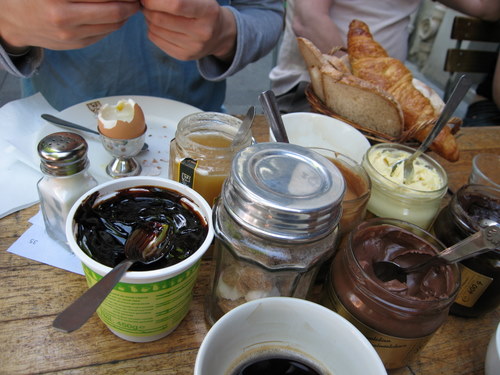
I just got back from New York a couple days ago and visited the cooking school I will be attending very soon. I cannot understate how amazing it was to visit a whole establishment entirely dedicated to the art of cooking. We are now far away from the days when cooking was considered a lesser art! The school has a library complete with DVDs of chef demonstrations and all the cook books one could ever hope for... as well as an auditorium where there are regular chef demonstrations. I was in absolute awe at the organization yet creativity emanating from these kitchens and cannot wait to begin the journey.
I have been meaning to post this recipe for a while now, but hadn't gotten around to it. It's a really great recipes for simple lemon cookies, with poppyseeds in the batter and sprinkled on top of each cookie. They are really easy to make but most importantly really tasty!

Recipe (adapted from Martha Stewart's Holiday Cookies)
1/4 cup of lemon juice
3 1/2 teaspoons of lemon zest
1 cup of unsalted butter
2 cups of all purpose flour
1 teaspoon of baking powder
1/2 teaspoon of coarse salt
1 1/2 cups of sugar
1 large egg
2 teaspoons of vanilla extract
1 tablespoon of poppy seeds and more for sprinkling
Preheat the oven to 350 degrees Fahrenheit. In a small pan, bring the lemon juice to a simmer. When it has reduced by half, add 1/2 cup of butter. Once the butter has melted remove from the heat and reserve.
In a bowl, mix the flour, baking powder and salt. In a separate bowl, whisk the remaining 1/2 cup of butter and 1 cup of sugar until the mixture is smooth and creamy (it helps to melt the butter for a few seconds in the microwave before hand). Then, add the egg and reserved lemon-butter mixture and whisk for about 3 minutes until the mixture is pale. Mix in the vanilla, tablespoon of poppy seeds and 2 the teaspoons of lemon zest. With an electrical beater on low speed mix the lemon mixture to the flour mixture and blend until smooth.
In a plate, stir the remaining 1/2 cup of sugar and 1/2 teaspoon of lemon zest.
Roll the dough into 1/4 inch balls and place on a parchment line cookie sheet making sure they are spaced out enough. Take a glass, dip it in some of the sugar/zest mixture and flatten out each ball to create an even circle of dough. Sprinkle some poppy seeds over the cookies and bake for 11 minutes or until the cookies are very slightly golden on the sides. Leave to cool before eating. Enjoy!
















